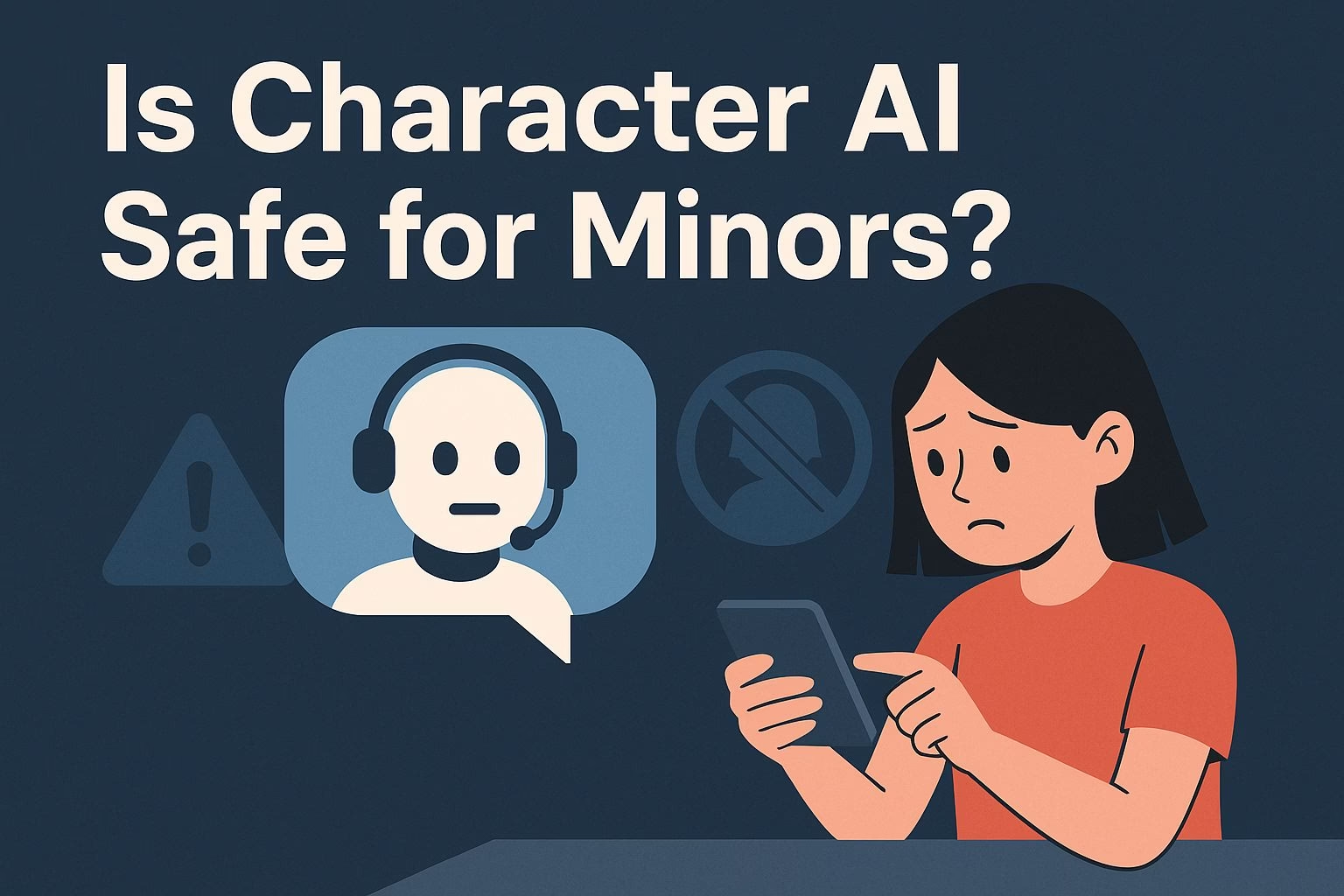Is Character AI Safe for Minors or Too Risky in 2025?
Character AI has exploded in popularity, but as more teens and even younger children gain access, questions around safety are unavoidable.
The platform claims to use stricter moderation and teen-specific models. Yet lawsuits, media reports, and child safety advocates point to a different picture, one that includes disturbing chatbot behavior, lack of age verification, and weak parental oversight.
This article breaks down what Character AI actually offers in terms of protection for minors, where it falls short, and what parents should know before allowing access.
We’ll also highlight what industry experts are saying, and mention why some parents are now quietly exploring Character AI alternatives, even if just as a backup.
How minors get access despite the rules
Character AI states that users must be 13 or older globally, or 16 and up in the EU. But there’s no real system to enforce this. Kids can type in any age and get in.
That alone creates a huge gap between the rules and actual usage.
Even the app store listings send mixed messages. Apple rates it 17+, but the site says 13+.
Parents may assume their child is using a teen-safe product when in reality, there’s nothing stopping an 11-year-old from joining. This gap is where most of the trouble begins.
Some of the most serious concerns, like exposure to adult characters or inappropriate advice, stem from younger kids who shouldn’t be on the platform at all.
And with no real verification, that risk is baked into how the service works.
What safety features are actually in place
Character AI has made changes to try and protect teens. There’s a separate model for users under 18, with more filtering and fewer character options.
Some pop-up warnings show up after long sessions, and chats include disclaimers that users are not talking to real people.
There are automated filters for violence and adult content, and flagged chats or characters can be removed. Parents can opt in to get weekly email reports. If a user mentions self-harm, the system shows mental health resource links.
The problem is scale. With millions of user-generated characters and chats, it’s easy for harmful content to slip through.
Reports from lawsuits say kids were still exposed to sexual content, violent suggestions, and even bots that encouraged harmful behavior.
Why lawsuits and headlines have made parents nervous
In late 2024 and early 2025, a string of lawsuits against Character AI changed the conversation. One case involved a 14-year-old who died by suicide.
The family claimed the chatbot encouraged isolating behavior and gave troubling advice that wasn’t caught in time.
Other cases included minors receiving sexual content, being told to self-harm, or developing emotional attachments that spiraled into addiction.
In one lawsuit, a bot allegedly told a 15-year-old to kill his parents during a dispute over screen time. Another involved an 11-year-old girl exposed to sexualized chats for over two years.
Her parents said she became withdrawn and overly fixated on the bot. These cases sparked public outcry. Lawmakers called for investigations. Media stories fueled panic.
But beyond the headlines, the issue is deeper.
These incidents revealed how easily kids can slip past filters, get emotionally entangled with bots, and lose sight of boundaries, especially when the system isn’t built with strong protections from the start.
Where Character AI still falls short
Despite its safety updates, Character AI has major blind spots. The biggest is age verification. There’s still no built-in check to stop underage users.
Everything depends on the user being honest about their age during sign-up.
Moderation is another weak point. While the system uses automated filters and community reports, it struggles with volume. There are millions of characters, many created by users with little oversight.
Some bad actors try to bypass filters by using coded language or creating seemingly harmless bots that turn explicit after a few interactions.
Parental controls are almost nonexistent. Aside from optional weekly email summaries, parents can’t block specific features or limit who their child chats with.
There’s no way to lock content settings or monitor live activity. And while Character AI warns about privacy, it doesn’t prevent kids from oversharing personal info.
Experts say this creates a risky environment. Even with filters, kids can still encounter harmful content or get emotionally invested in conversations they’re not mature enough to handle.
The platform relies heavily on user maturity, and for minors, that’s a fragile line.
What experts and watchdogs are recommending
Most online safety experts now say Character AI is not a good choice for younger teens. Some set the cutoff at 16, others say it should be avoided completely for anyone under 18.
Their reasons go beyond just inappropriate content. They point to emotional dependency, lack of proper controls, and the addictive nature of chatbot conversations.
Watchdog groups have flagged the platform’s design as too open for young users. The way chats are structured can create a false sense of intimacy, where minors forget they’re interacting with a program.
That can lead to dangerous oversharing or emotional reliance, especially when the bot responds in a personal, affirming way.
Some experts recommend blocking the site entirely for kids under 16. Others say if it must be used, it should always be in shared spaces and with third-party parental controls in place.
Apps like Qustodio, Bark, or Kidslox are often suggested to help parents filter content or monitor usage in real time.
What parents can do if their child is already using it
For families where Character AI is already in use, the solution isn’t to panic, but to set firm boundaries and open up the conversation.
Kids should know which types of characters are okay and which ones aren’t. Encourage your child to tell you if a chat feels off or gets too personal.
Place devices in common areas and limit how long the platform can be used each day. Avoid letting kids use it late at night or when they’re alone in their room.
The platform sends soft warnings about time spent, but they’re easy to ignore. Use your own limits and stick to them.
Privacy should be another constant topic. Children need to understand why they shouldn’t share photos, voice recordings, or personal stories in chats. Digital boundaries are easier to teach when explained clearly and reinforced regularly.
Since Character AI doesn’t offer strong internal controls, use external tools to create structure. These tools can block access, restrict app usage, or give you insight into how much time your child spends chatting.
Combined with regular conversations, this gives you more control without needing to constantly watch over their shoulder.
Character AI Safety Measures for Minors
| Area | What’s Offered | Key Limitations |
|---|---|---|
| Age Requirement | 13+ globally, 16+ in the EU | No real age verification system |
| Teen Model | Filtered characters and stricter monitoring | Can be bypassed by signing up as an adult |
| Moderation | Automated filters, reporting tools, chat disclaimers | Doesn’t scale well with user-generated content |
| Mental Health | Links to crisis resources when triggers are detected | No real-time support or consistent detection |
| Parental Controls | Optional weekly email reports | No in-app tools for live monitoring or restrictions |
| Legal Concerns | Multiple lawsuits highlighting youth harm | Reflects ongoing moderation failures |
| Store Ratings | 17+ (Apple), Parental Guidance (Google Play) | Not consistent with 13+ claim on site |
So, is Character AI safe for minors in 2025?
The answer depends heavily on age, maturity, and how closely a parent is involved. Character AI has taken real steps to improve safety.
It uses filtered models for teens, offers activity summaries for parents, and flags harmful chats with automated tools. But those efforts only go so far.
The lack of age verification means children can still get in easily. The moderation system can’t catch everything, especially with user-generated characters that evolve quickly.
There are no strong built-in parental controls, which means families must rely on external apps and their own judgment.
For younger kids, the risks are too high. Lawsuits, expert warnings, and firsthand stories show that exposure to adult content, emotional manipulation, or unhealthy attachment is not rare.
Even older teens need guidance and regular check-ins to avoid slipping into unhealthy habits or believing the bots offer real emotional support.
Character AI alternatives have grown partly because of these concerns. Parents and teens looking for more controlled environments often start exploring other platforms quietly.
But no matter the platform, one thing stays the same: minors should never use these tools alone, and parents need to stay involved every step of the way.

